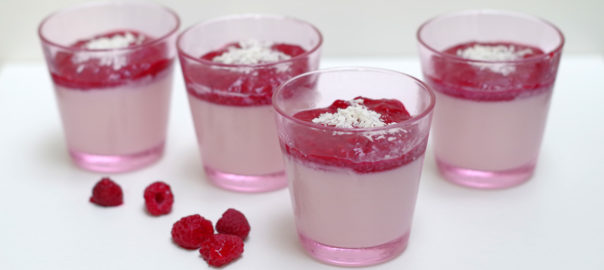Yoga Kitchen – Simple, healthy and plant-based
Coconut and co
You can make a purely vegan version of just about anything. Italian cuisine, for example, is rich in all kinds of dairy desserts based on cream and fresh cheese. Did you know that you can also make them using purely plant-based ingredients?
You can make vegan dairy-style desserts using the following alternatives:
- soy products such as tofu, silken tofu or soy cream
- Nuts, such as almonds and cashews
- Coconut
Here is a super simple alternative for a fresh and light Italian-style dessert: the classic panna cotta. If you translate that, it means “cooked cream”. We make this vegan version using coconut milk and soy cream.
To give the dessert a firm and at the same time soft texture, we use agar-agar.
Agar-agar is very well known in vegan and vegetarian cuisine and the perfect alternative to gelatine.
Agar-agar is extracted from red seaweeds.
Gelatine is no more or no less than melted and processed bone and offal from dead mammals.
I know immediately which of the two I prefer. And do you?
What you need for this vegan panna cotta
- One 400ml can of coconut milk
- One brick packet of soy cream of which you will need 75 ml
- Two tablespoons of agave syrup or rice syrup
- A teaspoon of agar-agar powder
- 300 to 400 grams of fresh or frozen fruit for the top layer
- Some grated coconut for the decoration
Read more below about the different coconut products on the market so you can purchase the right items for this recipe.
How to prepare
- Bring the coconut milk, agar-agar and soy cream together in a saucepan and put under heat
- Gently bring the mixture to the boil, stirring constantly
- Continue to boil for 2 to 3 minutes and keep on stirring
- Remove from the heat and divide evenly among 4 or more glasses
- Let cool completely. If during cooling you notice that the mixture loses its homogeneity and starts to layer, stir occasionally with a whisk
- Cool in the fridge for a few hours
- Before serving, puree the fruit into a coulis and pour it over the panna cottas
- Scatter some grated coconut over the top
In this example, we used raspberries. You could just as well use strawberries, kiwis or mangoes. Fresh or frozen fruit is best. On the other hand, you can also use rehydrated (soaked) dry fruit, for example dried mango or dried apricots.
So enjoy this italian style vegan panna cotta!
What type of coconut product should you choose?
I myself have struggled for a long time to see clearly through all these coconut products available.
There are many to be found on the market.
Here are the main ones:
Milks and creams
- Coconut water: the watery juice of the coconut to which people attribute many health benefits
- Coconut milk: made from the white flesh of the coconut with added water. The fat content may vary. For this recipe, use a coconut milk with 17-20% fat. Other versions can have up to 30% fat and are easier to whip into a firmer whipped cream texture. Not necessary for this recipe!
- Liquid coconut cream: with a higher coconut and fat content compared to the milk. Fresh coconut meat is used, but no water is added.
- Solid coconut cream: (creamed coconut) which is even more concentrated than liquid coconut cream and is sold in block form, like a bar of soap. It is made from the flesh of dried coconuts.
The oil
- Coconut oil: it is only the fat from the flesh of the coconut. This fat, although saturated, is very healthy and has a cooling effect on the body.
- Extra virgin coconut oil: it is pure and still has the typical taste and smell of coconut.
- Deodorised coconut oil: it is the result of a treatment or transformation process and has a neutral taste.
Flour and sugar
- Coconut flour: once the coconut oil has been extracted from the coconut flesh, the remaining pulp can be ground into coconut flour.
- Coconut blossom sugar: a full-flavoured, mineral-rich sugar that is made from the nectar of coconut blossoms.
I hope you can now see a bit more clearly.
Why is animal dairy unsuitable for many people?
Dairy products are unsuitable for the majority of the world’s human population, who experience moderate to severe digestive problems as a result. The result is abdominal pain, bloating of the intestine and sometimes diarrhoea. This phenomenon is called “lactose intolerance”. It is the so-called milk sugar or lactose that most people cannot digest, or cannot digest sufficiently. The phenomenon is described as an aberration, a deviation from a norm, but that is not at all true. It is part of the cultural myth surrounding milk.
It is the northernmost peoples who, over the course of history, had apparently adapted to digesting milk. That makes them something of an exception. That exception was then considered to be the norm after the Second World War.
But apart from that, about 80% of the world’s population is unable to digest the lactose in milk and milk products such as cheese. Being lactose intolerant is therefore not a disease, but simply the most normal thing in the world.
Why is deodorized coconut oil often cheaper than pure, undeodorized coconut oil?
Seems paradoxical, doesn’t it? The deodorized coconut oil undergoes an extra treatment, and still it is cheaper than the pure “extra virgin” coconut oil.
For the virgin coconut oil, only the better, fresh coconuts are used.
However, the deodorisation process also allows the use of coconuts of inferior quality. When the coconuts are harvested, the farmers pile them up in anticipation of processing. In the tropical climate, some of the nuts soon start to turn mouldy, which creates an unpleasant smell. With the deodorisation process (heating with steam), not only does the typical sweetish coconut smell disappear, but also the unpleasant odours of the mouldy nuts.

